Analysis of Boeing's Air Transport Forecasting and Market Research
VerifiedAdded on 2023/06/15
|18
|3917
|378
Report
AI Summary
This report provides a detailed analysis of Boeing's air transport forecasting and market research, comparing the Commercial Market Outlook reports for 2020-2039 and 2021-2040. It examines drivers of air travel passenger demand, demand for different sized passenger aircraft, economic development across world regions, personnel demand, and total fleet projections for 2040. The report also discusses passenger market developments and air cargo demand, highlighting assumptions used by Boeing in their forecasts. A critical analysis of projected growth in the aviation industry pre and post Covid-19 is presented, along with areas identified for potential improvement. The analysis reveals differences in GDP growth rate forecasts, aircraft demand, and regional economic development estimates between the two outlooks, likely influenced by the impact of the Covid-19 pandemic. Desklib provides access to this and other solved assignments for students.
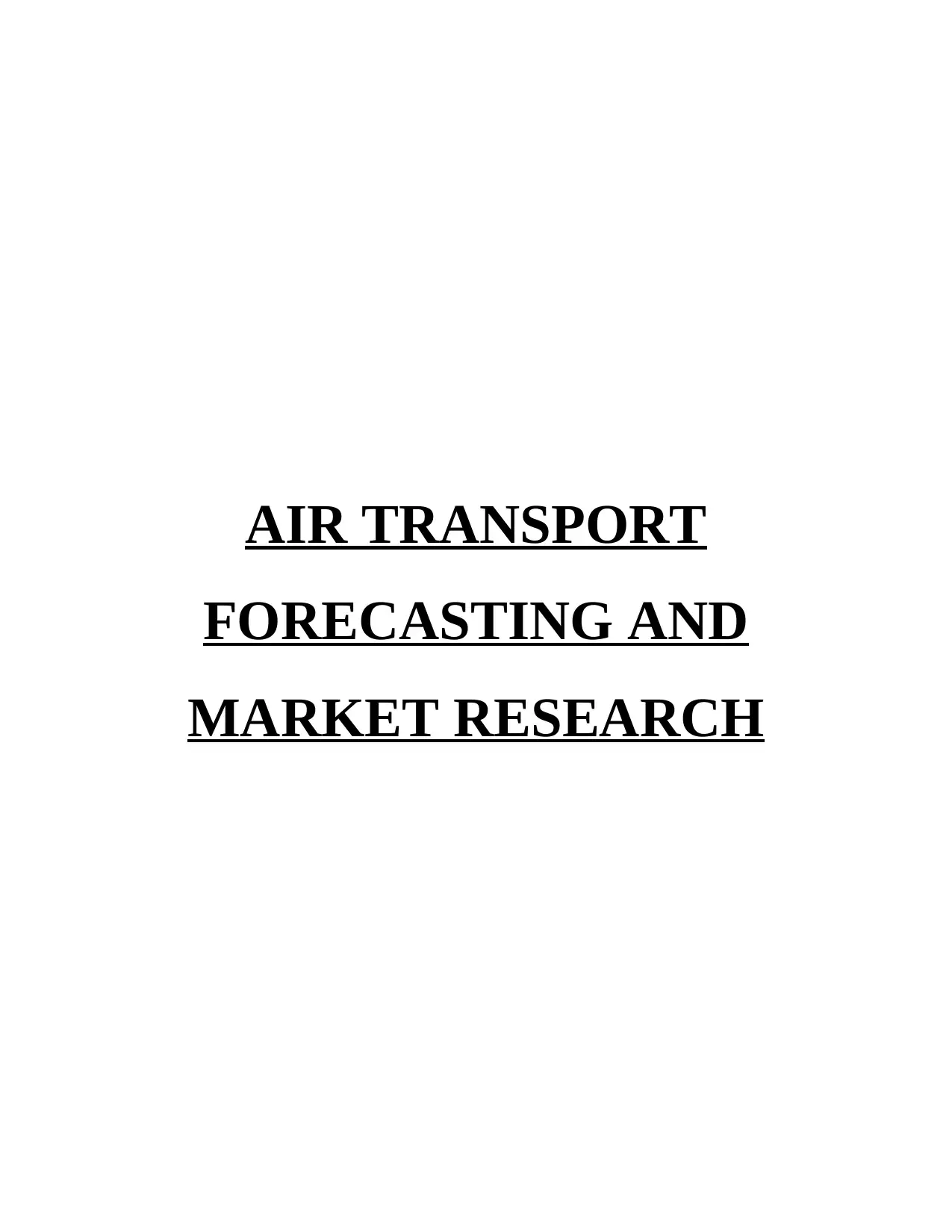
AIR TRANSPORT
FORECASTING AND
MARKET RESEARCH
FORECASTING AND
MARKET RESEARCH
Paraphrase This Document
Need a fresh take? Get an instant paraphrase of this document with our AI Paraphraser

TABLE OF CONTENTS
INTRODUCTION...........................................................................................................................3
Comparison of the two Forecast......................................................................................................3
Drivers of Air Travel Passenger Demand:..................................................................................3
Demand for different sized passenger aircraft:...........................................................................4
Economic development related to different world region:.........................................................5
Personnel Demand for different world region:...........................................................................7
2040 Total Fleets for different world region:..............................................................................9
Passenger market developments:..............................................................................................10
Air Cargo Demand:...................................................................................................................10
Assumptions used by Boeing in their most recent forecast (2021 – 2040 forecast)......................11
Critical analysis of the projected growth in the aviation industry pre and post Covid-19 and areas
where improvement is required.....................................................................................................12
CONCLUSION..............................................................................................................................14
REFERENCES..............................................................................................................................15
List of Figures and Tables
Figure 1: Drivers of Air Travel Passengers Demand at world level................................................4
Figure 2: Forecasted Demand for passenger’s aircraft of Boeing...................................................5
Figure 3: Economic GDP rate of different world regions................................................................7
Figure 4: Personnel demand for different world region...................................................................9
Figure 5: 2040 total fleets for different world region....................................................................11
Table 1: Drivers of Air Travel Passengers Demand at world level.................................................3
Table 2: Forecasted Demand for passenger’s aircraft of Boeing.....................................................4
Table 3: Economic GDP rate of different world regions.................................................................6
Table 4: Personnel demand for different world region....................................................................7
Table 5: 2040 total fleets for different world region......................................................................10
Table 6: Passenger market development........................................................................................12
INTRODUCTION...........................................................................................................................3
Comparison of the two Forecast......................................................................................................3
Drivers of Air Travel Passenger Demand:..................................................................................3
Demand for different sized passenger aircraft:...........................................................................4
Economic development related to different world region:.........................................................5
Personnel Demand for different world region:...........................................................................7
2040 Total Fleets for different world region:..............................................................................9
Passenger market developments:..............................................................................................10
Air Cargo Demand:...................................................................................................................10
Assumptions used by Boeing in their most recent forecast (2021 – 2040 forecast)......................11
Critical analysis of the projected growth in the aviation industry pre and post Covid-19 and areas
where improvement is required.....................................................................................................12
CONCLUSION..............................................................................................................................14
REFERENCES..............................................................................................................................15
List of Figures and Tables
Figure 1: Drivers of Air Travel Passengers Demand at world level................................................4
Figure 2: Forecasted Demand for passenger’s aircraft of Boeing...................................................5
Figure 3: Economic GDP rate of different world regions................................................................7
Figure 4: Personnel demand for different world region...................................................................9
Figure 5: 2040 total fleets for different world region....................................................................11
Table 1: Drivers of Air Travel Passengers Demand at world level.................................................3
Table 2: Forecasted Demand for passenger’s aircraft of Boeing.....................................................4
Table 3: Economic GDP rate of different world regions.................................................................6
Table 4: Personnel demand for different world region....................................................................7
Table 5: 2040 total fleets for different world region......................................................................10
Table 6: Passenger market development........................................................................................12
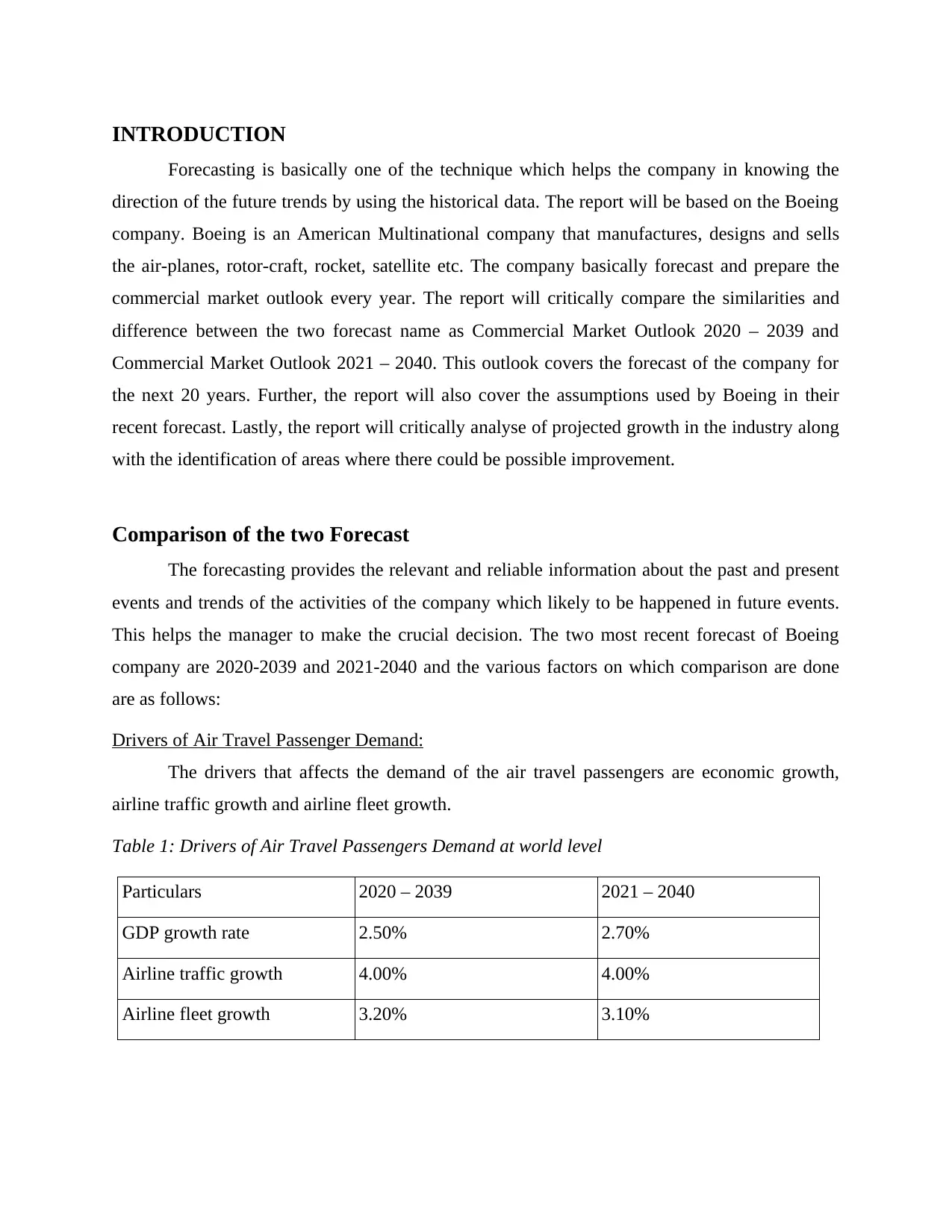
INTRODUCTION
Forecasting is basically one of the technique which helps the company in knowing the
direction of the future trends by using the historical data. The report will be based on the Boeing
company. Boeing is an American Multinational company that manufactures, designs and sells
the air-planes, rotor-craft, rocket, satellite etc. The company basically forecast and prepare the
commercial market outlook every year. The report will critically compare the similarities and
difference between the two forecast name as Commercial Market Outlook 2020 – 2039 and
Commercial Market Outlook 2021 – 2040. This outlook covers the forecast of the company for
the next 20 years. Further, the report will also cover the assumptions used by Boeing in their
recent forecast. Lastly, the report will critically analyse of projected growth in the industry along
with the identification of areas where there could be possible improvement.
Comparison of the two Forecast
The forecasting provides the relevant and reliable information about the past and present
events and trends of the activities of the company which likely to be happened in future events.
This helps the manager to make the crucial decision. The two most recent forecast of Boeing
company are 2020-2039 and 2021-2040 and the various factors on which comparison are done
are as follows:
Drivers of Air Travel Passenger Demand:
The drivers that affects the demand of the air travel passengers are economic growth,
airline traffic growth and airline fleet growth.
Table 1: Drivers of Air Travel Passengers Demand at world level
Particulars 2020 – 2039 2021 – 2040
GDP growth rate 2.50% 2.70%
Airline traffic growth 4.00% 4.00%
Airline fleet growth 3.20% 3.10%
Forecasting is basically one of the technique which helps the company in knowing the
direction of the future trends by using the historical data. The report will be based on the Boeing
company. Boeing is an American Multinational company that manufactures, designs and sells
the air-planes, rotor-craft, rocket, satellite etc. The company basically forecast and prepare the
commercial market outlook every year. The report will critically compare the similarities and
difference between the two forecast name as Commercial Market Outlook 2020 – 2039 and
Commercial Market Outlook 2021 – 2040. This outlook covers the forecast of the company for
the next 20 years. Further, the report will also cover the assumptions used by Boeing in their
recent forecast. Lastly, the report will critically analyse of projected growth in the industry along
with the identification of areas where there could be possible improvement.
Comparison of the two Forecast
The forecasting provides the relevant and reliable information about the past and present
events and trends of the activities of the company which likely to be happened in future events.
This helps the manager to make the crucial decision. The two most recent forecast of Boeing
company are 2020-2039 and 2021-2040 and the various factors on which comparison are done
are as follows:
Drivers of Air Travel Passenger Demand:
The drivers that affects the demand of the air travel passengers are economic growth,
airline traffic growth and airline fleet growth.
Table 1: Drivers of Air Travel Passengers Demand at world level
Particulars 2020 – 2039 2021 – 2040
GDP growth rate 2.50% 2.70%
Airline traffic growth 4.00% 4.00%
Airline fleet growth 3.20% 3.10%
⊘ This is a preview!⊘
Do you want full access?
Subscribe today to unlock all pages.

Trusted by 1+ million students worldwide
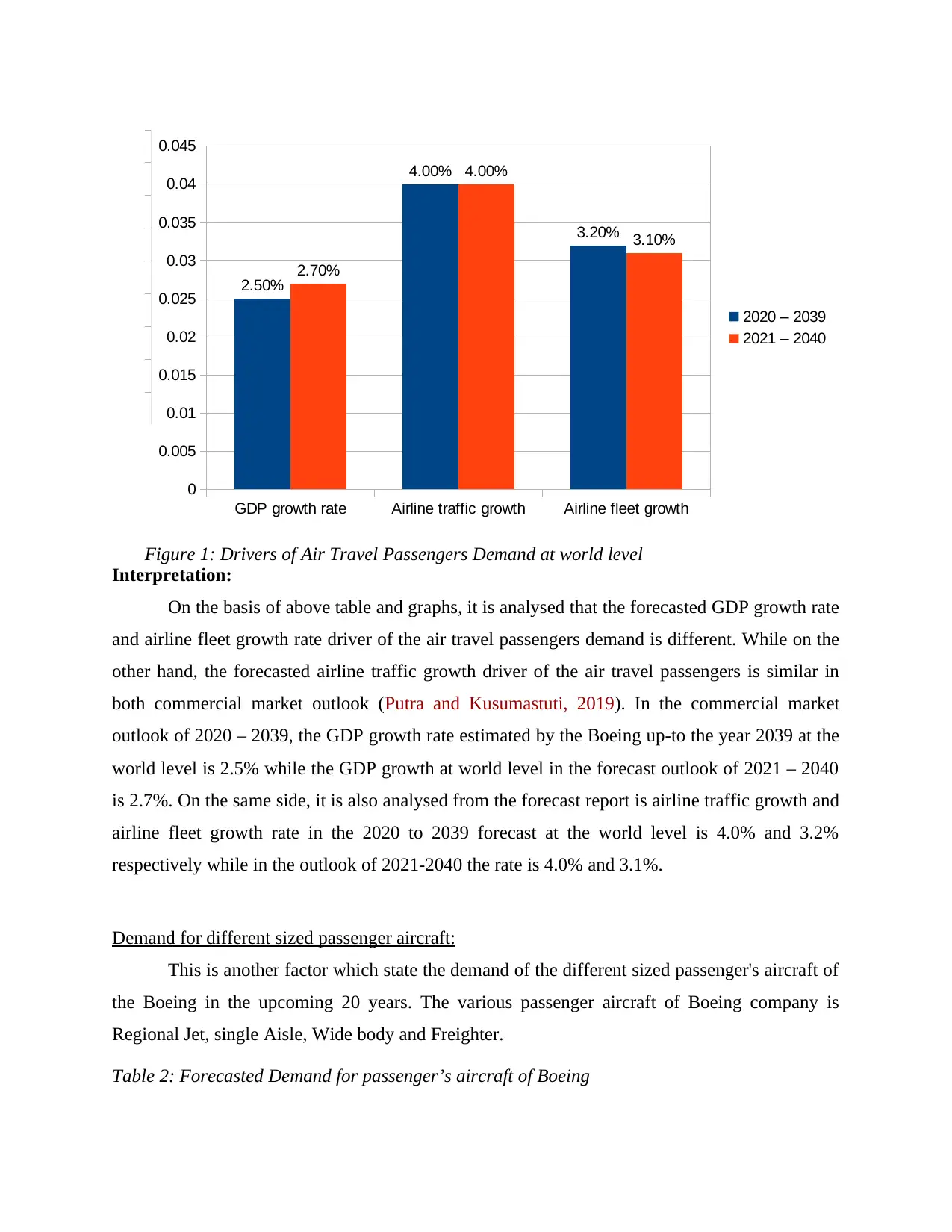
Interpretation:
On the basis of above table and graphs, it is analysed that the forecasted GDP growth rate
and airline fleet growth rate driver of the air travel passengers demand is different. While on the
other hand, the forecasted airline traffic growth driver of the air travel passengers is similar in
both commercial market outlook (Putra and Kusumastuti, 2019). In the commercial market
outlook of 2020 – 2039, the GDP growth rate estimated by the Boeing up-to the year 2039 at the
world level is 2.5% while the GDP growth at world level in the forecast outlook of 2021 – 2040
is 2.7%. On the same side, it is also analysed from the forecast report is airline traffic growth and
airline fleet growth rate in the 2020 to 2039 forecast at the world level is 4.0% and 3.2%
respectively while in the outlook of 2021-2040 the rate is 4.0% and 3.1%.
Demand for different sized passenger aircraft:
This is another factor which state the demand of the different sized passenger's aircraft of
the Boeing in the upcoming 20 years. The various passenger aircraft of Boeing company is
Regional Jet, single Aisle, Wide body and Freighter.
Table 2: Forecasted Demand for passenger’s aircraft of Boeing
GDP growth rate Airline traffic growth Airline fleet growth
0
0.005
0.01
0.015
0.02
0.025
0.03
0.035
0.04
0.045
2.50%
4.00%
3.20%
2.70%
4.00%
3.10%
2020 – 2039
2021 – 2040
Figure 1: Drivers of Air Travel Passengers Demand at world level
On the basis of above table and graphs, it is analysed that the forecasted GDP growth rate
and airline fleet growth rate driver of the air travel passengers demand is different. While on the
other hand, the forecasted airline traffic growth driver of the air travel passengers is similar in
both commercial market outlook (Putra and Kusumastuti, 2019). In the commercial market
outlook of 2020 – 2039, the GDP growth rate estimated by the Boeing up-to the year 2039 at the
world level is 2.5% while the GDP growth at world level in the forecast outlook of 2021 – 2040
is 2.7%. On the same side, it is also analysed from the forecast report is airline traffic growth and
airline fleet growth rate in the 2020 to 2039 forecast at the world level is 4.0% and 3.2%
respectively while in the outlook of 2021-2040 the rate is 4.0% and 3.1%.
Demand for different sized passenger aircraft:
This is another factor which state the demand of the different sized passenger's aircraft of
the Boeing in the upcoming 20 years. The various passenger aircraft of Boeing company is
Regional Jet, single Aisle, Wide body and Freighter.
Table 2: Forecasted Demand for passenger’s aircraft of Boeing
GDP growth rate Airline traffic growth Airline fleet growth
0
0.005
0.01
0.015
0.02
0.025
0.03
0.035
0.04
0.045
2.50%
4.00%
3.20%
2.70%
4.00%
3.10%
2020 – 2039
2021 – 2040
Figure 1: Drivers of Air Travel Passengers Demand at world level
Paraphrase This Document
Need a fresh take? Get an instant paraphrase of this document with our AI Paraphraser
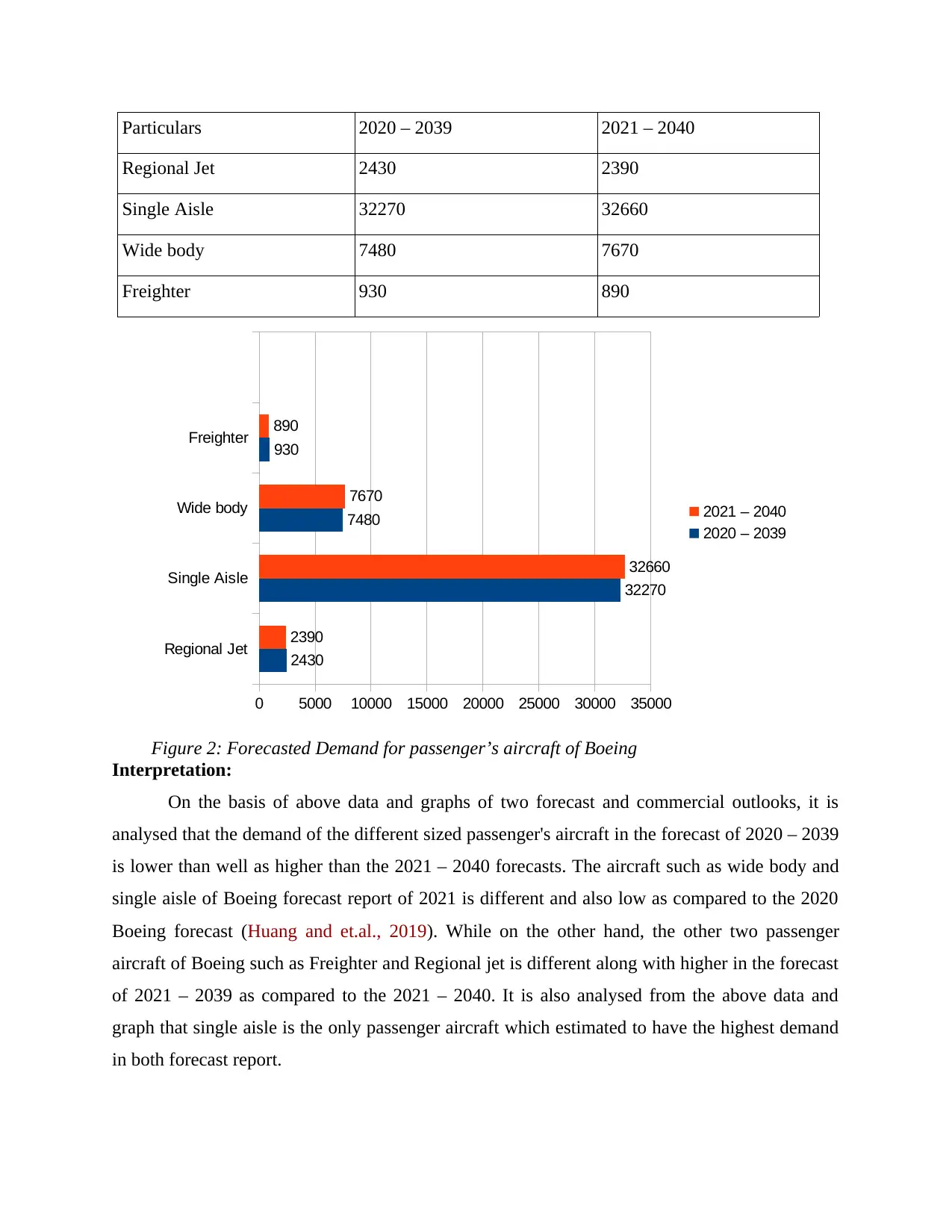
Particulars 2020 – 2039 2021 – 2040
Regional Jet 2430 2390
Single Aisle 32270 32660
Wide body 7480 7670
Freighter 930 890
Interpretation:
On the basis of above data and graphs of two forecast and commercial outlooks, it is
analysed that the demand of the different sized passenger's aircraft in the forecast of 2020 – 2039
is lower than well as higher than the 2021 – 2040 forecasts. The aircraft such as wide body and
single aisle of Boeing forecast report of 2021 is different and also low as compared to the 2020
Boeing forecast (Huang and et.al., 2019). While on the other hand, the other two passenger
aircraft of Boeing such as Freighter and Regional jet is different along with higher in the forecast
of 2021 – 2039 as compared to the 2021 – 2040. It is also analysed from the above data and
graph that single aisle is the only passenger aircraft which estimated to have the highest demand
in both forecast report.
Regional Jet
Single Aisle
Wide body
Freighter
0 5000 10000 15000 20000 25000 30000 35000
2430
32270
7480
930
2390
32660
7670
890
2021 – 2040
2020 – 2039
Figure 2: Forecasted Demand for passenger’s aircraft of Boeing
Regional Jet 2430 2390
Single Aisle 32270 32660
Wide body 7480 7670
Freighter 930 890
Interpretation:
On the basis of above data and graphs of two forecast and commercial outlooks, it is
analysed that the demand of the different sized passenger's aircraft in the forecast of 2020 – 2039
is lower than well as higher than the 2021 – 2040 forecasts. The aircraft such as wide body and
single aisle of Boeing forecast report of 2021 is different and also low as compared to the 2020
Boeing forecast (Huang and et.al., 2019). While on the other hand, the other two passenger
aircraft of Boeing such as Freighter and Regional jet is different along with higher in the forecast
of 2021 – 2039 as compared to the 2021 – 2040. It is also analysed from the above data and
graph that single aisle is the only passenger aircraft which estimated to have the highest demand
in both forecast report.
Regional Jet
Single Aisle
Wide body
Freighter
0 5000 10000 15000 20000 25000 30000 35000
2430
32270
7480
930
2390
32660
7670
890
2021 – 2040
2020 – 2039
Figure 2: Forecasted Demand for passenger’s aircraft of Boeing

Economic development related to different world region:
This is a factor in which comparison between the two Boeing forecast is done by using
the GDP growth rate of different world region.
Table 3: Economic GDP rate of different world regions
Region 2020 – 2039 2021 – 2040
Asia-pacific 3.60% 3.70%
China 4.30% 4.40%
South east Asia 4.00% 3.90%
South Asia 5.00% 4.90%
North east Asia 1.00% 1.00%
Oceania 2.10% 2.30%
North America 1.90% 2.10%
Europe 1.20% 1.40%
Middle east 2.30% 2.80%
Latin America 2.20% 2.40%
Russia and Central Asia 1.50% 2.10%
Africa 2.60% 3.00%
World 2.50% 2.70%
This is a factor in which comparison between the two Boeing forecast is done by using
the GDP growth rate of different world region.
Table 3: Economic GDP rate of different world regions
Region 2020 – 2039 2021 – 2040
Asia-pacific 3.60% 3.70%
China 4.30% 4.40%
South east Asia 4.00% 3.90%
South Asia 5.00% 4.90%
North east Asia 1.00% 1.00%
Oceania 2.10% 2.30%
North America 1.90% 2.10%
Europe 1.20% 1.40%
Middle east 2.30% 2.80%
Latin America 2.20% 2.40%
Russia and Central Asia 1.50% 2.10%
Africa 2.60% 3.00%
World 2.50% 2.70%
⊘ This is a preview!⊘
Do you want full access?
Subscribe today to unlock all pages.

Trusted by 1+ million students worldwide
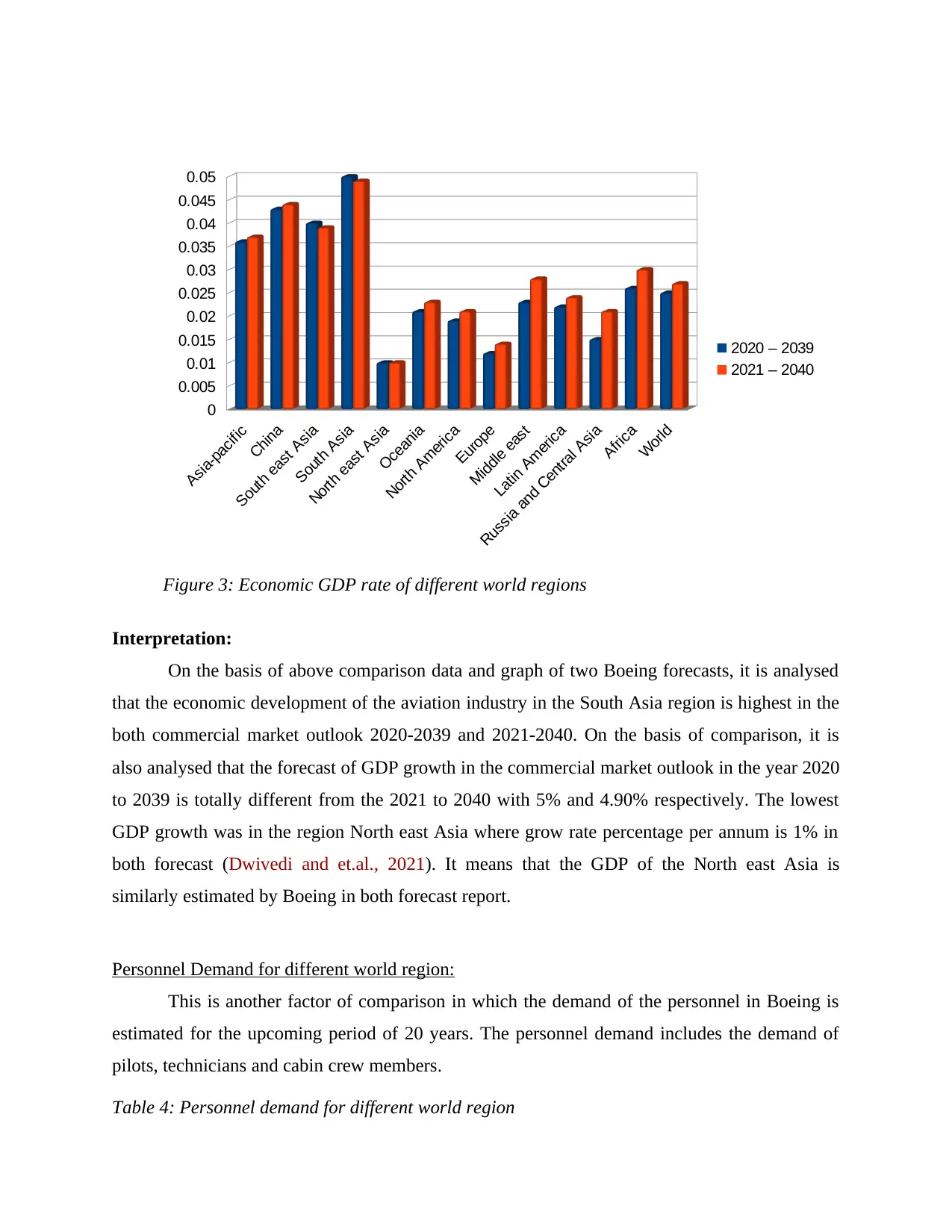
Interpretation:
On the basis of above comparison data and graph of two Boeing forecasts, it is analysed
that the economic development of the aviation industry in the South Asia region is highest in the
both commercial market outlook 2020-2039 and 2021-2040. On the basis of comparison, it is
also analysed that the forecast of GDP growth in the commercial market outlook in the year 2020
to 2039 is totally different from the 2021 to 2040 with 5% and 4.90% respectively. The lowest
GDP growth was in the region North east Asia where grow rate percentage per annum is 1% in
both forecast (Dwivedi and et.al., 2021). It means that the GDP of the North east Asia is
similarly estimated by Boeing in both forecast report.
Personnel Demand for different world region:
This is another factor of comparison in which the demand of the personnel in Boeing is
estimated for the upcoming period of 20 years. The personnel demand includes the demand of
pilots, technicians and cabin crew members.
Table 4: Personnel demand for different world region
Asia-pacific
China
South east Asia
South Asia
North east Asia
Oceania
North America
Europe
Middle east
Latin America
Russia and Central Asia
Africa
World
0
0.005
0.01
0.015
0.02
0.025
0.03
0.035
0.04
0.045
0.05
2020 – 2039
2021 – 2040
Figure 3: Economic GDP rate of different world regions
On the basis of above comparison data and graph of two Boeing forecasts, it is analysed
that the economic development of the aviation industry in the South Asia region is highest in the
both commercial market outlook 2020-2039 and 2021-2040. On the basis of comparison, it is
also analysed that the forecast of GDP growth in the commercial market outlook in the year 2020
to 2039 is totally different from the 2021 to 2040 with 5% and 4.90% respectively. The lowest
GDP growth was in the region North east Asia where grow rate percentage per annum is 1% in
both forecast (Dwivedi and et.al., 2021). It means that the GDP of the North east Asia is
similarly estimated by Boeing in both forecast report.
Personnel Demand for different world region:
This is another factor of comparison in which the demand of the personnel in Boeing is
estimated for the upcoming period of 20 years. The personnel demand includes the demand of
pilots, technicians and cabin crew members.
Table 4: Personnel demand for different world region
Asia-pacific
China
South east Asia
South Asia
North east Asia
Oceania
North America
Europe
Middle east
Latin America
Russia and Central Asia
Africa
World
0
0.005
0.01
0.015
0.02
0.025
0.03
0.035
0.04
0.045
0.05
2020 – 2039
2021 – 2040
Figure 3: Economic GDP rate of different world regions
Paraphrase This Document
Need a fresh take? Get an instant paraphrase of this document with our AI Paraphraser
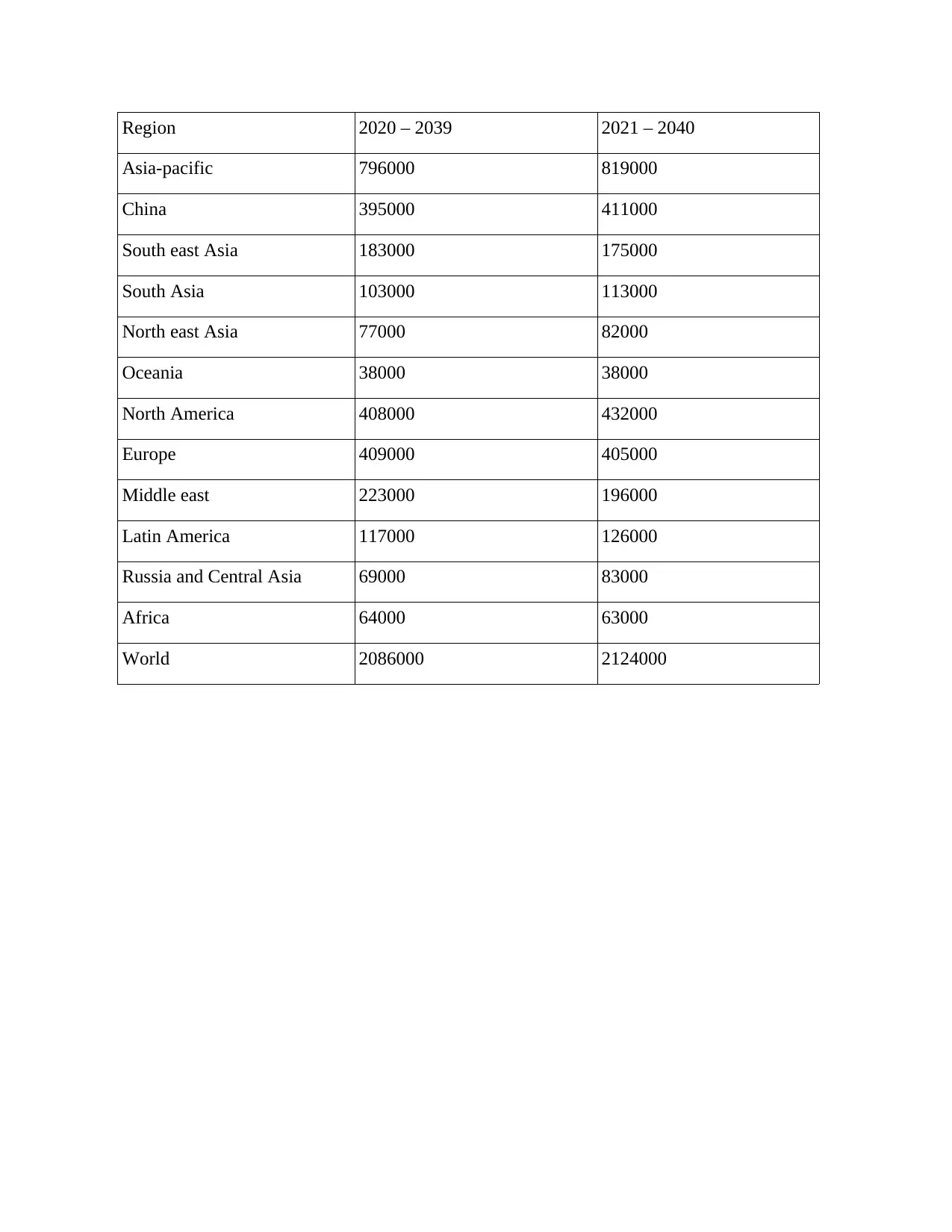
Region 2020 – 2039 2021 – 2040
Asia-pacific 796000 819000
China 395000 411000
South east Asia 183000 175000
South Asia 103000 113000
North east Asia 77000 82000
Oceania 38000 38000
North America 408000 432000
Europe 409000 405000
Middle east 223000 196000
Latin America 117000 126000
Russia and Central Asia 69000 83000
Africa 64000 63000
World 2086000 2124000
Asia-pacific 796000 819000
China 395000 411000
South east Asia 183000 175000
South Asia 103000 113000
North east Asia 77000 82000
Oceania 38000 38000
North America 408000 432000
Europe 409000 405000
Middle east 223000 196000
Latin America 117000 126000
Russia and Central Asia 69000 83000
Africa 64000 63000
World 2086000 2124000
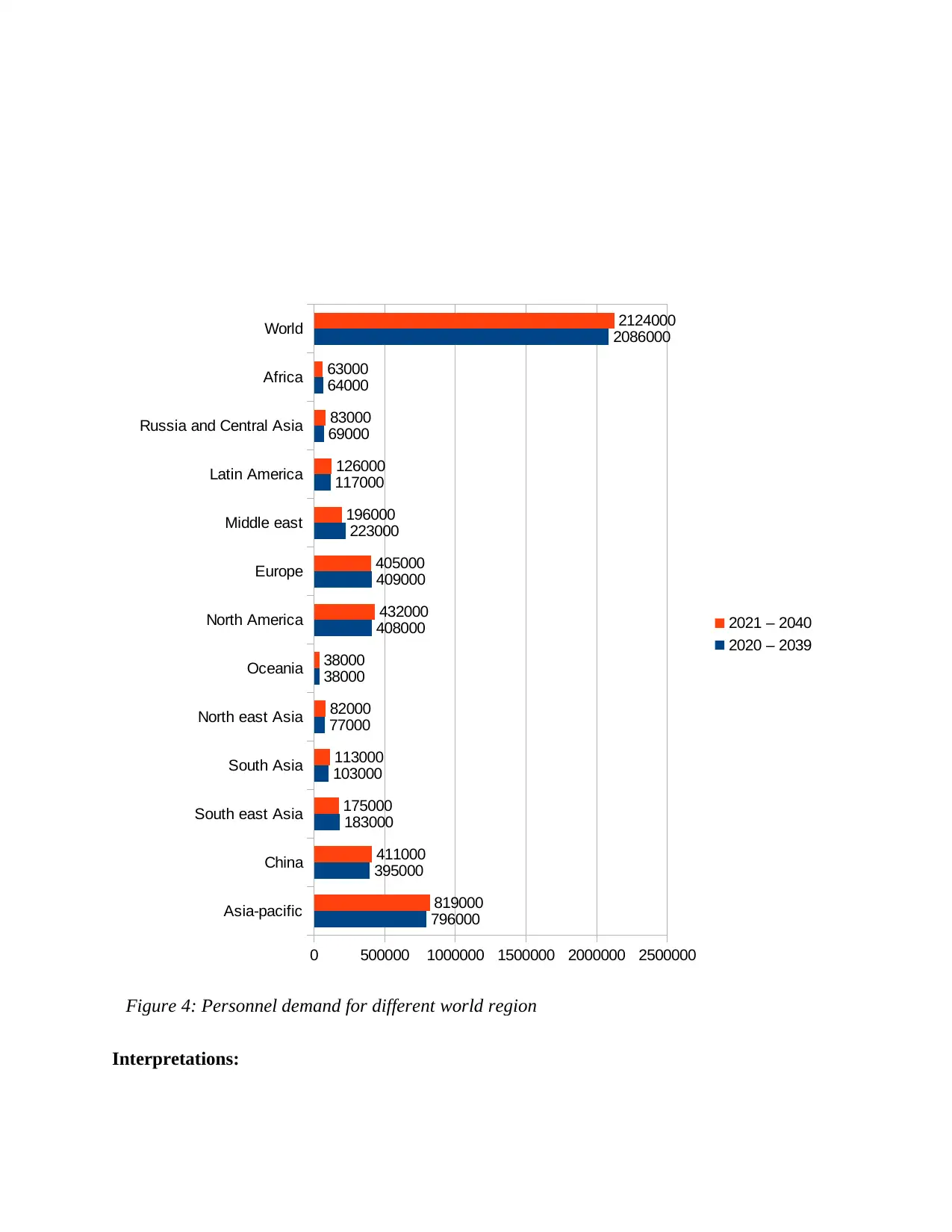
Interpretations:
Asia-pacific
China
South east Asia
South Asia
North east Asia
Oceania
North America
Europe
Middle east
Latin America
Russia and Central Asia
Africa
World
0 500000 1000000 1500000 2000000 2500000
796000
395000
183000
103000
77000
38000
408000
409000
223000
117000
69000
64000
2086000
819000
411000
175000
113000
82000
38000
432000
405000
196000
126000
83000
63000
2124000
2021 – 2040
2020 – 2039
Figure 4: Personnel demand for different world region
Asia-pacific
China
South east Asia
South Asia
North east Asia
Oceania
North America
Europe
Middle east
Latin America
Russia and Central Asia
Africa
World
0 500000 1000000 1500000 2000000 2500000
796000
395000
183000
103000
77000
38000
408000
409000
223000
117000
69000
64000
2086000
819000
411000
175000
113000
82000
38000
432000
405000
196000
126000
83000
63000
2124000
2021 – 2040
2020 – 2039
Figure 4: Personnel demand for different world region
⊘ This is a preview!⊘
Do you want full access?
Subscribe today to unlock all pages.

Trusted by 1+ million students worldwide
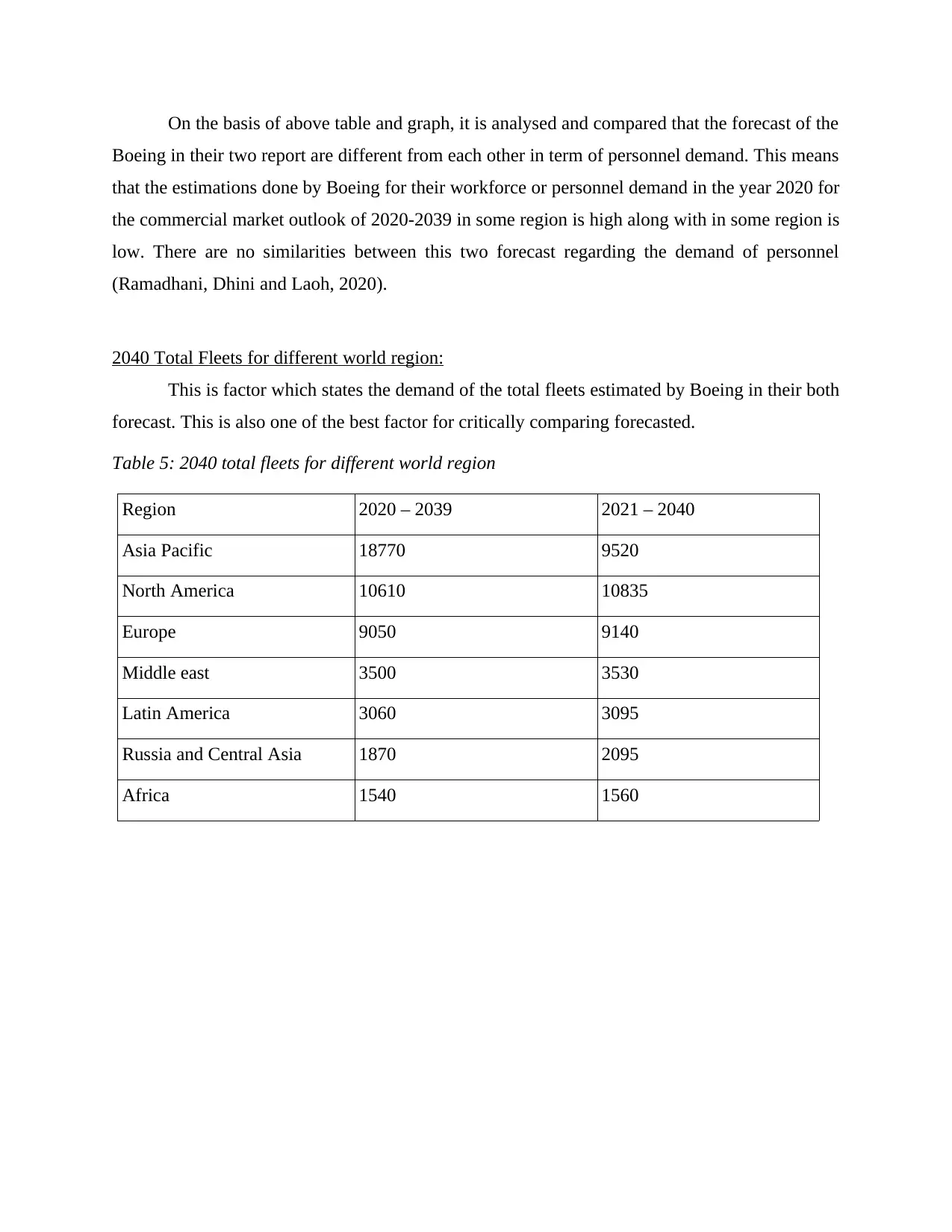
On the basis of above table and graph, it is analysed and compared that the forecast of the
Boeing in their two report are different from each other in term of personnel demand. This means
that the estimations done by Boeing for their workforce or personnel demand in the year 2020 for
the commercial market outlook of 2020-2039 in some region is high along with in some region is
low. There are no similarities between this two forecast regarding the demand of personnel
(Ramadhani, Dhini and Laoh, 2020).
2040 Total Fleets for different world region:
This is factor which states the demand of the total fleets estimated by Boeing in their both
forecast. This is also one of the best factor for critically comparing forecasted.
Table 5: 2040 total fleets for different world region
Region 2020 – 2039 2021 – 2040
Asia Pacific 18770 9520
North America 10610 10835
Europe 9050 9140
Middle east 3500 3530
Latin America 3060 3095
Russia and Central Asia 1870 2095
Africa 1540 1560
Boeing in their two report are different from each other in term of personnel demand. This means
that the estimations done by Boeing for their workforce or personnel demand in the year 2020 for
the commercial market outlook of 2020-2039 in some region is high along with in some region is
low. There are no similarities between this two forecast regarding the demand of personnel
(Ramadhani, Dhini and Laoh, 2020).
2040 Total Fleets for different world region:
This is factor which states the demand of the total fleets estimated by Boeing in their both
forecast. This is also one of the best factor for critically comparing forecasted.
Table 5: 2040 total fleets for different world region
Region 2020 – 2039 2021 – 2040
Asia Pacific 18770 9520
North America 10610 10835
Europe 9050 9140
Middle east 3500 3530
Latin America 3060 3095
Russia and Central Asia 1870 2095
Africa 1540 1560
Paraphrase This Document
Need a fresh take? Get an instant paraphrase of this document with our AI Paraphraser
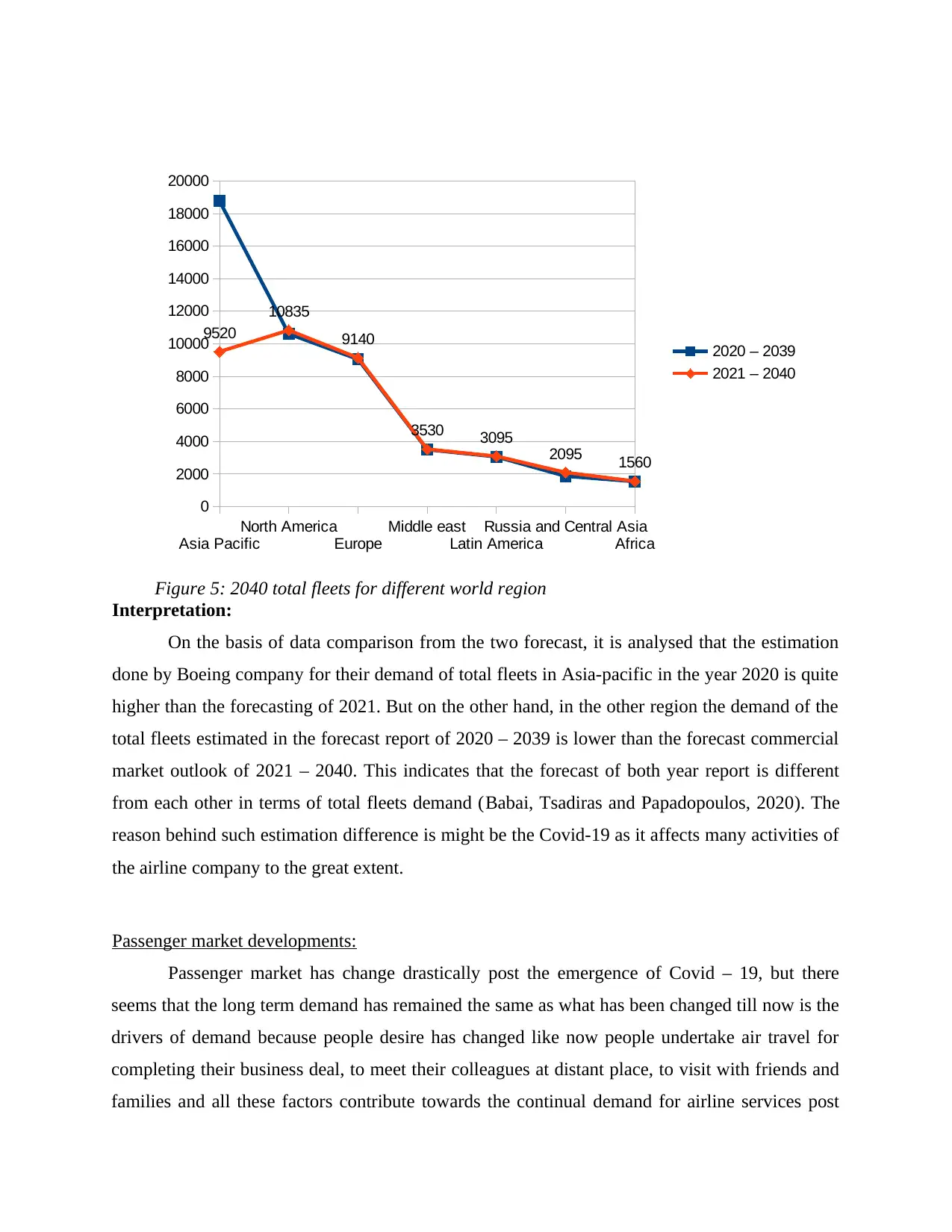
Interpretation:
On the basis of data comparison from the two forecast, it is analysed that the estimation
done by Boeing company for their demand of total fleets in Asia-pacific in the year 2020 is quite
higher than the forecasting of 2021. But on the other hand, in the other region the demand of the
total fleets estimated in the forecast report of 2020 – 2039 is lower than the forecast commercial
market outlook of 2021 – 2040. This indicates that the forecast of both year report is different
from each other in terms of total fleets demand (Babai, Tsadiras and Papadopoulos, 2020). The
reason behind such estimation difference is might be the Covid-19 as it affects many activities of
the airline company to the great extent.
Passenger market developments:
Passenger market has change drastically post the emergence of Covid – 19, but there
seems that the long term demand has remained the same as what has been changed till now is the
drivers of demand because people desire has changed like now people undertake air travel for
completing their business deal, to meet their colleagues at distant place, to visit with friends and
families and all these factors contribute towards the continual demand for airline services post
Asia Pacific
North America
Europe
Middle east
Latin America
Russia and Central Asia
Africa
0
2000
4000
6000
8000
10000
12000
14000
16000
18000
20000
9520
10835
9140
3530 3095
2095 1560
2020 – 2039
2021 – 2040
Figure 5: 2040 total fleets for different world region
On the basis of data comparison from the two forecast, it is analysed that the estimation
done by Boeing company for their demand of total fleets in Asia-pacific in the year 2020 is quite
higher than the forecasting of 2021. But on the other hand, in the other region the demand of the
total fleets estimated in the forecast report of 2020 – 2039 is lower than the forecast commercial
market outlook of 2021 – 2040. This indicates that the forecast of both year report is different
from each other in terms of total fleets demand (Babai, Tsadiras and Papadopoulos, 2020). The
reason behind such estimation difference is might be the Covid-19 as it affects many activities of
the airline company to the great extent.
Passenger market developments:
Passenger market has change drastically post the emergence of Covid – 19, but there
seems that the long term demand has remained the same as what has been changed till now is the
drivers of demand because people desire has changed like now people undertake air travel for
completing their business deal, to meet their colleagues at distant place, to visit with friends and
families and all these factors contribute towards the continual demand for airline services post
Asia Pacific
North America
Europe
Middle east
Latin America
Russia and Central Asia
Africa
0
2000
4000
6000
8000
10000
12000
14000
16000
18000
20000
9520
10835
9140
3530 3095
2095 1560
2020 – 2039
2021 – 2040
Figure 5: 2040 total fleets for different world region

pandemic (Zhang and Graham, 2020). The following factors can be interpreted for evaluating
passenger market developments:
Table 6: Passenger market development
Factors 2020 – 2039 2021 - 2040
Service market size $9040B $9540B
Flow of passenger traffic
between regions
4.00% 4.00%
The value or size of service market targeted by Boeing seems to have increase in the
forecast made in the year 2021. The reasons of such increase can be due to the drivers of demand
for air travel as it is continued to encourage travellers to accomplish their visit through airline
services as it seems to be safer and secure in terms of the requirements of precautions to be taken
with regard to pandemic. Alternately, the flow of passenger traffic between regions reflect no
change and it remains the same within the two forecasts of Boeing due to the progress of market
since pandemic and the fundamentals of growth seems to be strong in long term.
Air Cargo Demand:
As per the forecast done in 2019 – 2039, air cargo market is experiencing strong demand
due to the reason of cyclical and structural market dynamics. There was a higher air cargo yields
along with reduced long haul international networks which creates a favourable condition for
many airlines to utilize their passenger wide body fleets for the purpose of cargo in an attempt to
generate required cash flow and industry capacity (Gelhausen, Berster and Wilken, 2018). The
air cargo traffic in June 2021 has surpassed the levels in 2019 by 11% and 2020 by 24%. Also,
air cargo acts as a tool for lead time recovery as there was a delayed production with the rise of
supply chain challenges. Such maritime challenges along with less availability of capacity results
in boosted demand for air cargo. Price multiple of maritime transport has shrunk by 50% as
compared to air cargo making it a more attractive option for transport despite constrained air
cargo capacity. Air cargo demand has also increased with the trend of online shopping and as the
e-commerce sector is growing, there seems great opportunities for future growth of air cargo.
passenger market developments:
Table 6: Passenger market development
Factors 2020 – 2039 2021 - 2040
Service market size $9040B $9540B
Flow of passenger traffic
between regions
4.00% 4.00%
The value or size of service market targeted by Boeing seems to have increase in the
forecast made in the year 2021. The reasons of such increase can be due to the drivers of demand
for air travel as it is continued to encourage travellers to accomplish their visit through airline
services as it seems to be safer and secure in terms of the requirements of precautions to be taken
with regard to pandemic. Alternately, the flow of passenger traffic between regions reflect no
change and it remains the same within the two forecasts of Boeing due to the progress of market
since pandemic and the fundamentals of growth seems to be strong in long term.
Air Cargo Demand:
As per the forecast done in 2019 – 2039, air cargo market is experiencing strong demand
due to the reason of cyclical and structural market dynamics. There was a higher air cargo yields
along with reduced long haul international networks which creates a favourable condition for
many airlines to utilize their passenger wide body fleets for the purpose of cargo in an attempt to
generate required cash flow and industry capacity (Gelhausen, Berster and Wilken, 2018). The
air cargo traffic in June 2021 has surpassed the levels in 2019 by 11% and 2020 by 24%. Also,
air cargo acts as a tool for lead time recovery as there was a delayed production with the rise of
supply chain challenges. Such maritime challenges along with less availability of capacity results
in boosted demand for air cargo. Price multiple of maritime transport has shrunk by 50% as
compared to air cargo making it a more attractive option for transport despite constrained air
cargo capacity. Air cargo demand has also increased with the trend of online shopping and as the
e-commerce sector is growing, there seems great opportunities for future growth of air cargo.
⊘ This is a preview!⊘
Do you want full access?
Subscribe today to unlock all pages.

Trusted by 1+ million students worldwide
1 out of 18